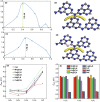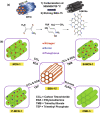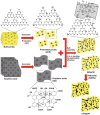DFT-Guided Design and Fabrication of Carbon-Nitride-Based Materials for Energy Storage Devices: A Review
- PMID: 34138201
- PMCID: PMC8187489
- DOI: 10.1007/s40820-020-00522-1
DFT-Guided Design and Fabrication of Carbon-Nitride-Based Materials for Energy Storage Devices: A Review
Abstract
Carbon nitrides (including CN, C2N, C3N, C3N4, C4N, and C5N) are a unique family of nitrogen-rich carbon materials with multiple beneficial properties in crystalline structures, morphologies, and electronic configurations. In this review, we provide a comprehensive review on these materials properties, theoretical advantages, the synthesis and modification strategies of different carbon nitride-based materials (CNBMs) and their application in existing and emerging rechargeable battery systems, such as lithium-ion batteries, sodium and potassium-ion batteries, lithium sulfur batteries, lithium oxygen batteries, lithium metal batteries, zinc-ion batteries, and solid-state batteries. The central theme of this review is to apply the theoretical and computational design to guide the experimental synthesis of CNBMs for energy storage, i.e., facilitate the application of first-principle studies and density functional theory for electrode material design, synthesis, and characterization of different CNBMs for the aforementioned rechargeable batteries. At last, we conclude with the challenges, and prospects of CNBMs, and propose future perspectives and strategies for further advancement of CNBMs for rechargeable batteries.
Keywords: Anode; Carbon nitrides; Density functional theory; Metal-ion batteries; g-C3N4.
Figures



























References
-
- Su Z, Liu J, Li M, Zhu Y, Qian S, et al. Defect engineering in titanium-based oxides for electrochemical energy storage devices. Electrochem. Energ. Rev. 2020;3:286–343. doi: 10.1007/s41918-020-00064-5. - DOI
-
- Zhang Y, Shi G, Qin J, Lowe SE, Zhang S, Zhao H, Zhong YL. Recent progress of direct ink writing of electronic components for advanced wearable devices. ACS Appl. Electron. Mater. 2019;1(9):1718–1734. doi: 10.1021/acsaelm.9b00428. - DOI
-
- Wu Z, Xie J, Xu ZJ, Zhang S, Zhang Q. Recent progress in metal–organic polymers as promising electrodes for lithium/sodium rechargeable batteries. J. Mater. Chem. A. 2019;7(9):4259–4290. doi: 10.1039/C8TA11994E. - DOI
-
- Liu C, Liu X, Tan J, Wang Q, Wen H, Zhang C. Nitrogen-doped graphene by all-solid-state ball-milling graphite with urea as a high-power lithium ion battery anode. J. Power Sources. 2017;342:157–164. doi: 10.1016/j.jpowsour.2016.11.110. - DOI
Publication types
LinkOut - more resources
Full Text Sources
